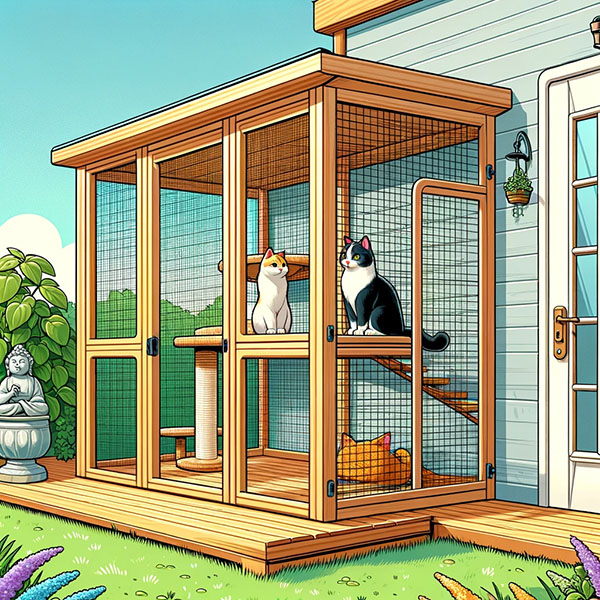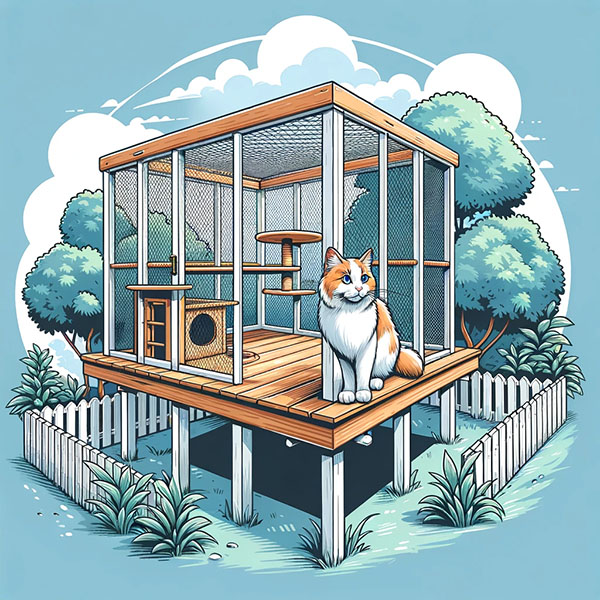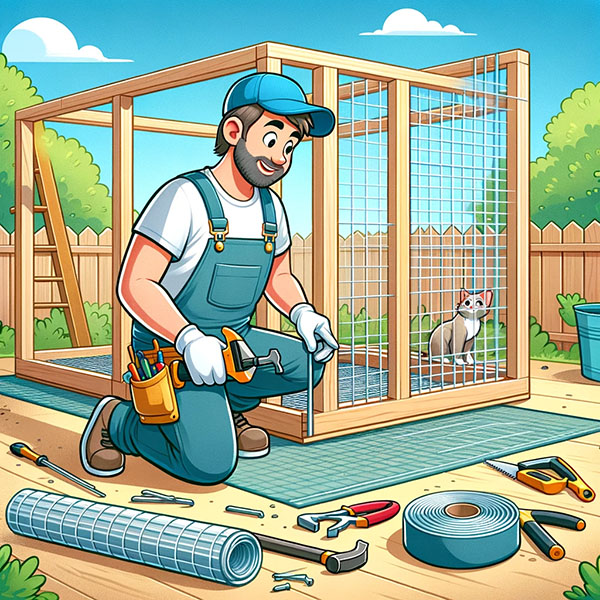Crafting the perfect haven for your feline friend while ensuring their safety can be challenging, but catios offers a brilliant solution gaining popularity among cat owners. A catio, essentially a patio for your cat, provides a secure outdoor cat enclosure where your beloved pet can enjoy fresh air, bask in the sun, and observe the world from the safety of an enclosed environment. Whether you live in a bustling city apartment or a quiet suburban home, a catio can be tailored to fit your space and your cat's needs.
In this guide, we'll walk you through everything you need to know about catios—from the benefits for your cat's health and well-being to what you need to consider before adding a catio to your space.
What is a Catio?

In the enchanting world of pet companionship, cats stand as mysterious and alluring creatures, captivating us with their grace, independence, and playful antics. With their soft purrs and curious eyes, these beloved feline friends hold a special place in the hearts of millions. But as much as they adore lounging in the warmth of a sunbeam indoors, their adventurous spirits often yearn for the excitement of the outdoors. This is where the concept of a "catio" comes into play—a sanctuary that marries the comfort of indoor safety with the thrill of outdoor exploration.
A catio, succinctly put, is a cat enclosure or "cat patio" designed to offer the best of both worlds. It is a thoughtfully designed enclosure that provides a safe environment for cats to experience the outdoors, mitigating the risks typically associated with free-roaming cats. Catio are typically made of mesh or wire and commonly feature a cat door for easy access. The cat door allows the cats to enter a catio through the window, wall, or a door to enjoy outdoor space year-round safely. These enclosures can range from simple window box designs to elaborate structures that include cat hammocks, cat tunnels, bridges, ramps, cat trees, and perch, all tailored to feline preferences.
The purpose of a catio extends beyond just providing a leisure space—it's about safety, enrichment, and protection. Catios serve as protective enclosures to safeguard our feline companions, preventing accidents and injuries from traffic, predators, or other potential hazards. They also protect local wild animals by preventing cats, who are natural hunters, from catching birds and small mammals.
Furthermore, a catio offers mental and physical stimulation for cats, keeping them engaged with their environment. This enrichment can reduce common behavioral issues and health problems associated with a sedentary indoor lifestyle, such as obesity and depression. A catio can offer endless entertainment and exercise opportunities by incorporating climbing shelves, hiding spots, and toys.
The Benefits of a Catio
Ratios, or more accurately "catios" when referring to cat enclosures, benefit both feline companions and their human caretakers. These specially designed spaces enhance indoor cats' quality of life and contribute positively to the broader ecological community. Let's delve into the multifaceted advantages of catios:
1. Safety from Outdoor Hazards
One of the paramount benefits of a catio is the safety it provides. Outdoor environments, while stimulating, are fraught with dangers such as predators (e.g., coyotes, larger birds of prey), vehicular traffic, and exposure to contagious diseases from other animals. Catios offers a secure environment where cats can enjoy the outdoors without these risks, ensuring peace of mind for their owners.
2. Enrichment by Allowing Cats to Experience the Outdoors
Cats have a natural curiosity and hunting instinct that can be stifled in purely indoor settings. Catios offer an enriching environment that captivates feline senses with the outdoors's sights, sounds, and fragrances. This enrichment can lead to happier, more content cats with reduced signs of boredom or anxiety. Catio is perfect for any cat lover seeking new ways to enrich their cat's life without worrying about their safety.
3. Protection for Local Wildlife
Cats are skilled hunters, and when allowed to roam freely outdoors, they can significantly impact local bird populations and other small wildlife. By containing cats within a catio, their natural hunting behaviors don't threaten surrounding wildlife and protect birds, helping preserve local ecosystems.
4. Stress Reduction for Cats and Their Owners
The catio's security helps reduce stress for both cats and their owners. Cats benefit from a reduced risk of injury and illness, while owners can relax knowing their pets are safe. This stress-free environment fosters a stronger bond between cats and their humans, enhancing their overall well-being.
5. Potential to Improve Indoor Behaviors by Offering Outdoor Experiences
Cats with access to a catio may exhibit fewer behavioral issues indoors. The stimulation from being in a catio can decrease tendencies towards destructive behaviors, such as scratching furniture or aggression, as it allows them to expend energy positively. Furthermore, the added variety to their environment can mitigate issues like overgrooming or incessant meowing, which are often signs of boredom or stress.
How Much Does A Catio Cost?

The expense of a catio can fluctuate significantly depending on various factors such as its size, the materials utilized, design intricacy, and whether you choose to undertake a do-it-yourself project or opt for a professionally installed unit. Here's a rough breakdown to give you an idea:
DIY Catio Costs
Materials Only: For those who choose the DIY route, the cost primarily involves materials such as wood, wire mesh, screws, and any additional features like shelves, ramps, or cat-safe plants. A basic, small catio can start at $100 to $200 if you keep it simple and source materials wisely. The cost can easily rise to $500 or more for larger or more elaborate designs, depending on the complexity and the quality of materials chosen.
You can find DIY catio plans available for different skill levels online to get started. If you need a custom catio, seek a catio designer who can come up with custom-designed cat patios specially designed for your space.
Premade Catio Kits
Small to Medium Kits: These can range from $150 to $600, offering a variety of sizes and complexities. They're typically easy to assemble and come with all the necessary components.
Large or Custom Kits: For more spacious or custom-designed catios, prices can start around $600 and go up to $2,000 or more. These kits offer more room for exploration and often include multiple levels, ramps, and perches.
Professional Installation
Custom Designs: Hiring a professional to design and install a catio can significantly increase the cost. Prices can range from $1,000 to over $5,000, depending on the scale of the project and the materials used. Professional installations offer the advantage of custom configurations tailored to your space and needs, potentially adding value to your property.
What to Consider Before Adding A Catio To Your Space

Size and Space
The first step in planning a catio is assessing the available space in your home and considering your cat's needs. The size of the catio should be proportionate to the number of cats that will use it, allowing ample room for each cat to move, climb, and explore without feeling cramped. If you have two cats or more, you will want to make sure there is enough space without creating unwanted conflicts. Whether you're dealing with a small balcony or a large backyard, the objective is to utilize the space effectively to cater to your cat's active and restful tendencies.
Location
Choosing the right location for a catio involves considering safety and environmental factors. It should be positioned in an area protected from potential threats, such as predators and traffic, ensuring your cat's outdoor time is worry-free. The ideal location will also offer a mix of sun for basking and shaded areas for cooling down, which is especially important during the warmer months to prevent overheating and discomfort.
Materials and Durability
Choosing the appropriate materials is essential to ensure the durability and safety of the catio. Materials should be chosen based on their ability to withstand local weather conditions, including rain, snow, and sun, ensuring the catio remains a secure and comfortable environment year-round. Opting for high-quality, durable materials also means the structure will be robust enough to keep your cat safely enclosed and protect against any potential predators or escape attempts.
Design and Features
The design of the catio should cater to a cat's natural instincts and preferences. Incorporating climbing structures such as shelves, a cat tunnel, a cat hammock, or even a cat tree can satisfy their urge to climb and survey their surroundings from a height. Comfortable resting areas are essential for relaxation and leisure, while toys and enrichment activities can provide mental stimulation and physical exercise, keeping your cat entertained and engaged.
Access and Security
Ensuring easy yet secure access to the catio is vital. A cat door that allows for a smooth transition between the indoor and outdoor environments can make the catio more accessible and enjoyable for your cat. Security features such as locks and latches are important to prevent your cat from escaping and to keep unwanted visitors out, ensuring the safety and integrity of the catio space.
Maintenance
Consideration of maintenance requirements is essential for keeping the catio clean and in good condition. The design should enable effortless cleaning and upkeep, ensuring a hygienic setting that your cat can thoroughly enjoy. Additionally, the catio should be constructed to facilitate easy repairs or replacements of parts as needed, extending its longevity and usability.
Legal and Community Considerations
Before building a catio, it's important to check any local zoning laws, regulations, or homeowner association rules that could affect your plans. Additionally, consider the potential impact on your neighbors, especially in terms of visibility and proximity, to maintain good relations and ensure the catio does not become a source of dispute.
Budget
Planning a budget for a catio necessitates careful consideration to ensure you can manage all essential expenses without exceeding your financial limits. This includes the initial materials and construction and any additional features, maintenance, or future modifications. Establishing a clear budget will serve as a roadmap, guiding your decisions and ensuring the project remains financially manageable.
Future Plans
Finally, when designing a catio, it's essential to consider its flexibility and adaptability to accommodate future changes. Whether it's the possibility of moving, changing the layout of your outdoor space, or accommodating more cats, the catio should be versatile enough to adjust to new circumstances, ensuring it remains a valuable and usable space for years to come.
